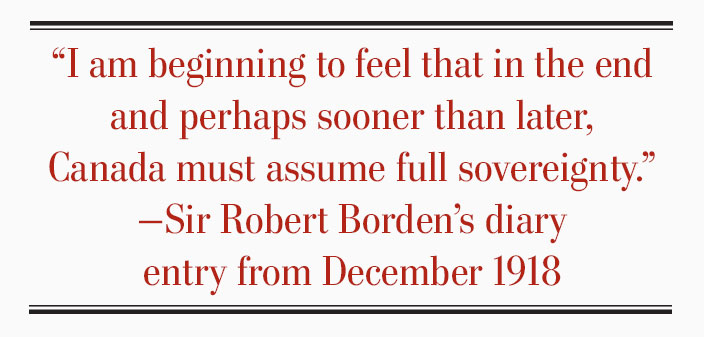We sat down with Gary Luton, Director of Treaty Law at Global Affairs Canada to discuss the most famous treaty of the 20th Century, the Treaty of Versailles.


The signing of the Armistice at 5:45 a.m. on Nov. 11, 1918, ended the fighting between the Allies and Germany, but it was the signing of the Treaty of Versailles on June 28, 1919, that ushered in peace.
It also helped Canada take a step toward sovereignty.
Sir Robert Borden was prime minister on Aug. 4, 1914, when a telegram informed him his country was at war. Britain had declared war on Germany. Canada, as a dominion, was automatically also at war. And Canada answered enthusiastically, contributing volunteers, food, money and materials.
Borden was a champion of Canada’s right to handle its own affairs, separate from and not subservient to Britain, and the war only increased his determination to improve Canada’s status on the world stage. In a letter to his wife Laura in 1917, he said Canada “is a nation that is not a nation. It is about time to alter it.”

The dominions sent soldiers “upon the principle of equal nationhood,” yet had no say in planning and policy, he argued. As the war went on and the supply of men from the dominions waned, Britain became willing to consult with the dominions and India.
“They are fighting not for us, but with us,” said British Prime Minister David Lloyd George.
Borden attended the first Imperial War Cabinet in London in the spring of 1917 and won the passage of a resolution guaranteeing that dominions would continue to be consulted.
But that did not happen before the Battle of Passchendaele, in which Canadian Corps suffered so many casualties. At the second Imperial War Cabinet in the summer of 1918, Borden’s threats to stop supplying Canadian troops in the absence of consultation sparked hearings into the conduct of the war in Britain. The resulting report concluded in part that dominions should be consulted on war policy, but the war ended before any action was taken.

Borden then attended the planning sessions for the Paris Peace Conference and, arguing that Canada had paid the price of equality with blood, fought for and won separate representation. That, in addition to filling one of the five seats on the British delegation, gave Canada a “particularly effective position,” said Borden. By “constant effort and firm insistence,” Canada and other dominions had won the right to sign the treaty independently.
The treaty was signed by 67 representatives of 27 countries, including two German cabinet ministers. Lloyd George and four cabinet ministers signed for the United Kingdom, and indented under their signatures were those of representatives of Canada, Australia, New Zealand, South Africa and India.
Borden—recalled to Canada to deal with crises, predominantly the Winnipeg General Strike (see page 52)—did not himself sign it. It was signed for Canada by Minister of Justice Charles Doherty and Minister of Customs Arthur Sifton.

Borden’s efforts also obtained, over objections chiefly of the United States, membership in the League of Nations and the International Labour Organization and their elected councils. The battle won, Borden hastened home.
Signing the treaty, he said prior to Parliament ratifying it on Sept. 12, 1919, furthered dominions’ “equality of nationhood. Each nation…must likewise have its voice as to…the issue of peace or of war.”
Autonomy developed slowly. Thus Canada did not automatically enter the Second World War when the United Kingdom declared war on Sept. 3, 1939, but independently declared war a week later.

Advertisement












